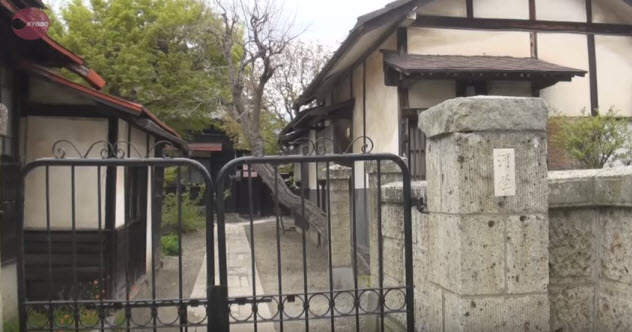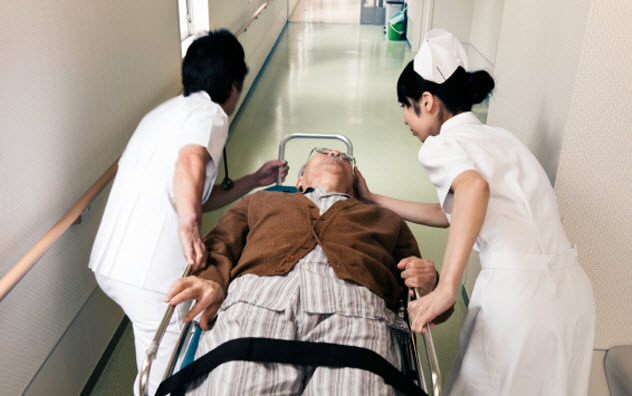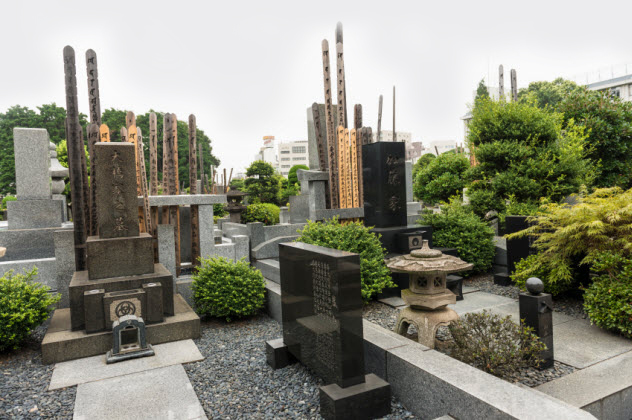 Animals
Animals  Animals
Animals  Weird Stuff
Weird Stuff 10 Weird Things People Used to Do at New Year’s
 Our World
Our World 10 Archaeological Discoveries of 2025 That Refined History
 Weird Stuff
Weird Stuff 10 Fascinating Facts You Might Not Know About Snow
 Miscellaneous
Miscellaneous Top 10 Things Crypto Was Supposed to Change & What Actually Did
 History
History 10 Huge Historical Events That Happened on Christmas Eve
 Music
Music 10 Surprising Origin Stories of Your Favorite Holiday Songs
 History
History 10 Less Than Jolly Events That Occurred on December 25
 Weird Stuff
Weird Stuff 10 Funny Ways That Researchers Overthink Christmas
 Politics
Politics 10 Political Scandals That Sent Crowds Into the Streets
 Animals
Animals 10 Species That Refused to Go Extinct
 Weird Stuff
Weird Stuff 10 Weird Things People Used to Do at New Year’s
 Our World
Our World 10 Archaeological Discoveries of 2025 That Refined History
Who's Behind Listverse?

Jamie Frater
Head Editor
Jamie founded Listverse due to an insatiable desire to share fascinating, obscure, and bizarre facts. He has been a guest speaker on numerous national radio and television stations and is a five time published author.
More About Us Weird Stuff
Weird Stuff 10 Fascinating Facts You Might Not Know About Snow
 Miscellaneous
Miscellaneous Top 10 Things Crypto Was Supposed to Change & What Actually Did
 History
History 10 Huge Historical Events That Happened on Christmas Eve
 Music
Music 10 Surprising Origin Stories of Your Favorite Holiday Songs
 History
History 10 Less Than Jolly Events That Occurred on December 25
 Weird Stuff
Weird Stuff 10 Funny Ways That Researchers Overthink Christmas
 Politics
Politics 10 Political Scandals That Sent Crowds Into the Streets
10 Dark Facts About The Worst Chemical Terror Attack In History
On March 20, 1995, the Tokyo subway system became the target of the worst bioterror attack in modern history. Five men riding different trains simultaneously punctured bags of liquid sarin with sharpened umbrella tips, releasing a deadly cloud of nerve gas.
The carnage that followed was unprecedented in postwar Japan. Commuters collapsed on platforms, blood foaming from their mouths. The streets outside stations resembled war zones. By the time the fog of confusion cleared, 13 people were dead and thousands were injured.
Since then, there have been many rumors of terrorists plotting chemical attacks on other cities. Bioterror has seen anthrax scares in the US and fears of mustard gas in ISIS’s arsenal. Yet the 1995 Tokyo attack remains the deadliest to be carried out by a nongovernment group.
It ushered in a new era in Japanese society, one characterized by a loss of optimism and a sense of soul-searching paranoia. It also redefined what modern terrorism could be in an age of weapons of mass destruction. The lessons learned remain grimly relevant today.
10 The Cult And The Gas
In 1938, researchers at the IG Farben chemical company in Nazi Germany hit upon an ingenious new product. Known as chemical 146, it disrupted the central nervous system, causing uncontrollable muscle spasms and death.
In the twisted world of Hitler’s Third Reich, inventing such a weapon was considered an accomplishment worth honoring. Chemical 146 was renamed for the chemists behind it: Schrader, Ambros, Ritter, and Van der Linde. Its new name was sarin.
Over the next few decades, sarin became notorious as one of the deadliest nerve gases in existence. During the Iran-Iraq War in the 1980s, Saddam dropped rockets full of the stuff on his enemies, killing tens of thousands.
In one particularly gruesome incident, he deployed sarin against the Kurdish town of Halabja. Around 5,000 died in unimaginable agony. It was a war crime, but worse still, it was an inspiration.
Many thousands of miles away in Japan, senior chemists of the cult Aum Shinrikyo saw sarin in the news and took note. By the late 1980s, the group was researching weapons of mass destruction to bring about the apocalypse. Run by blind guru Shoko Asahara, the group was an End Times cult committed to ending the world. Unlike most such cults, they had the means to do it.
Over the years, they’d begun recruiting scientists and wealthy patrons from Japanese and Russian society. Millions had been spent on germ warfare and AK-47 manufacturing programs. Although they’d managed to cultivate some anthrax, most of these attempts came to nothing.
Then sarin became big news, and the cult was seemingly inspired. Abandoning germs, they diverted all their funds into a sarin program. By the early 1990s, their new doomsday weapon was ready.
9 The Guru And His Followers
Now might be a good time to fill you in on exactly what sort of cult Aum was. Although they wound up becoming a doomsday group, they hadn’t started out that way.
Founded by Shoko Asahara during the bubble economy years—when piles of money could be made and splashed on the most inane stuff—Aum combined Christianity, Buddhism, yoga, and New Age teachings with a solid dose of utter insanity.
Most of that craziness was centered around Asahara himself. Calling himself a reincarnation of the Hindu god Shiva, Asahara commanded a devotion in his followers that was almost frightening.
Aum members would drink vials of his blood or cups of his dirty bathwater to attain enlightenment. Others would happily undergo pain therapies so extreme that they were later classed as torture.
Yet the group was spectacularly good at recruiting from the higher classes of society. Wealthy Russians joined. Highly educated Japanese were sucked into Aum’s vortex. In his deluded mind, Asahara apparently believed that his high-class followers would be able to control Japanese society.
In 1990, he organized a scheme in which 24 of them ran in elections for the Japanese Diet. Convinced that they would win, he saw it as the first step in his political takeover of Japan. The Japanese public saw it differently. Aum’s party received a mere 1,700 votes.
In the wake of this defeat, Aum’s goals suddenly shifted to sparking the apocalypse. In a sign of how far gone its members were, the cultists were so overjoyed when they finally produced sarin that they wrote a song to celebrate.
According to David Kaplan and Andrew Marshall, one verse went:
It came from Nazi Germany,
A dangerous little chemical weapon,
Sarin, sarin.
If you inhale the mysterious vapor,
You will fall with bloody vomit from your mouth,
Sarin, sarin, sarin,
The chemical weapon.
8 Preparing The Attack

As the Sun set on June 27, 1994, Yoshiyuki Kono had no idea that he was about to be thrust into a nightmare. A wealthy machinery salesman living in a leafy suburb of Matsumoto, Kono was the archetypal Japanese success story. Then his wife fell horribly ill at 11:00 PM. In a panic, Kono dialed 119 (the Japanese 911). That call would seal his fate.
Although Kono didn’t know it, his wife was suffering from the symptoms of sarin poisoning. Only minutes beforehand, members of Aum had parked a modified van behind Kono’s house and begun spraying the neighborhood with poison gas.
The operation was a dry run for their subsequent attack in Tokyo. Asahara was especially keen to see how many people they could kill. After 30 minutes, the entire neighborhood was suffering horrifying convulsions.
When doctors arrived just after midnight, they found almost 50 people milling in the street, their noses streaming and their vision nearly gone. Inside the houses, more people were convulsing, frothing at the mouth, or simply dead.
As it was a hot summer’s night, many had gone to bed with their windows open. That decision resulted in their deaths. All told, seven people died that night, with over 200 more badly sickened.
Aum considered their trial run a success but decided that they would need a better target next time. One with no ventilation where nobody could run from the poison cloud.
As for Yoshiyuki Kono, he became the prime suspect in the case because he was the first to alert police. He was arrested, and the media dragged his name through the mud. As he lay in the hospital recovering and his wife slipped into a brain-damaging coma brought on by the sarin, the whole of Japan turned on him.
Thanks to Aum’s actions, Kono not only lost his beloved wife, he also lost his reputation, his livelihood, and nearly his sanity.
7 The Attack Begins
On a bright spring morning nine months after the Matsumoto attack, 30-year-old Kenichi Hirose boarded the Marunouchi Line of the Tokyo subway. In his hands, Hirose carried an umbrella and a plastic bag containing two small packages.
It was rush hour, and the trains were crammed with workers heading into the center of the city. Unobserved by anyone around him, Hirose quietly took a seat amid the bustle and waited.
At the same moment, shortly after 7:30 AM, four other men were boarding the Tokyo subway at different stations. Toru Toyoda, Masato Yokoyama, Yasuo Hayashi, and Ikuo Hayashi all carried umbrellas and plastic bags. All were on trains bound for Tsukiji Station in the heart of the government district. All appeared to be waiting for something.
Just before 8:00 AM, all five men simultaneously let their packages slip to the carriage floor. With quick movements, they drove the tips of their umbrellas into the plastic, puncturing it.
Then they got to their feet, elbowed their way out of the cars, and disappeared into the morning rush hour. As the trains shunted on to their next stations, no one noticed the small pools of liquid beginning to form under the punctured bags.
Ironically, the first indication that something was wrong came not from any innocent people sitting in the subway cars but from Kenichi Hirose. As he stepped into the getaway car, he began to tremble uncontrollably. His breath caught in his throat. His mouth refused to form words.
Despite Aum’s precautions, Hirose became the first person that morning to come down with symptoms of sarin poisoning. He certainly wouldn’t be the last.
6 Panic Sets In
Within minutes of the packages being punctured, it was clear that something was horribly wrong. On the Hibiya Line train poisoned by Yasuo Hayashi, passengers were beginning to cough uncontrollably.
By 8:02 AM, some were on the floor vomiting. Others were clutching their eyes in agony. As the train pulled into Kodemmacho Station, a passenger kicked the sarin-filled bags out onto the platform. It was at this point that things got really bad.
Three lines were now clearly affected, yet no one had any idea what was going on. A rumor swept through the system that there had been an explosion at Tsukiji in the government district—possibly a terrorist bombing.
The line operators pulled several trains from service. Unfortunately, some of those stopped at platforms were the trains awash with sarin. They opened their doors, disgorging toxic fumes into the faces of commuters. For those trains that were kept in place, the passengers were trapped inside with the killer gas.
Kazuyuki Takahashi was one of the unlucky ones caught in the panic. He boarded the Hibiya Line train at Hatchobori to find his fellow passengers collapsed on the floor, spasms racking their bodies.
The door closed, and he had to ride the stricken carriage all the way to the next stop. By the time he escaped onto Tsukiji platform, he was dying of sarin poisoning.
At Kasumigaseki, three subway employees—Toshiaki Toyoda, Kazumasa Takahashi, and Tsuneo Hishinuma—were dispatched to remove suspicious plastic packages from a train. They carried out their work without protective equipment, simply wrapping the sarin-drenched plastic in newspaper.
Within minutes, Toyoda was feeling deathly ill. He later reported that he turned around just in time to see Takahashi and Hishinuma collapse, blood foaming from their mouths. Aum’s deadly attack had just claimed its first two victims.
5 Apocalypse Now
For those trapped underground, it must have felt like Asahara’s longed-for apocalypse had finally arrived. The sarin wafted through the subway tunnels, seeping onto platforms. It clung to survivors’ clothes and affected others as they ran for the surface. By 8:30 AM, the transport network was paralyzed. Still, the casualties piled up.
The effects of sarin make for disturbing reading. Some began vomiting uncontrollably. Others fell into comas from which they would never awake. For many more, their eyes were the main source of agony.
Sarin forces the pupils to contract to the size of pinpricks. To those affected, it looks like someone has turned a dimmer switch down on the Sun. A bright spotlight can appear to be a dingy bulb. Many of those affected went permanently blind. In one gruesome case, a woman’s contact lenses fused to her eyeballs. Doctors had to surgically remove both of her eyes.
Other victims were paralyzed or suffered tremendous convulsions. With the cause still unknown, many of those who rushed in to rescue others were poisoned, too. Paramedics treating victims found their hands shaking uncontrollably.
Outside the gassed stations, bodies of the sick and injured began to pile up. Central Tokyo resembled a war zone. Traffic ground to a halt. Hospitals overflowed. It began to seem like the end of the world.
4 The Attack Unravels

Many miles away at that exact moment, Hiroshi Morita was preparing to publish his report about the earlier Matsumoto attack. A doctor who had treated victims at the scene, he was now considered Japan’s leading authority on sarin poisoning.
By sheer luck, he happened to have the television on as the first reports from Tokyo began to roll in. Morita realized instantly what had happened. He also knew exactly what he had to do.
It’s impossible to stress how unprepared Tokyo was for a nerve gas attack. Despite being one of the biggest cities on Earth, you could still leave your bike unlocked in the street. No one was prepared for any form of attack, especially one using Nazi weapons of mass destruction.
When the first sarin victims made it to the hospital complaining of blindness, nurses coldly told them to see an eye doctor. Since the first few hours of sarin poisoning can determine whether you recover or sustain lifelong injuries, this was a potentially disastrous attitude. Luckily, Hiroshi Morita was on hand to help.
As the attack unfolded, Morita frantically phoned the Tokyo Metropolitan Government. When they seemed uninterested in his diagnosis, he assembled a team of colleagues. Using Morita’s newly finished report on treating sarin victims, they began to call each hospital in Tokyo individually, telling them exactly what to do.
It was a decisive moment in Japan’s day of terror. Thanks to Morita’s actions, hospitals immediately began treating anyone with symptoms for sarin poisoning. Although the casualties that day were horrendous, without Morita’s quick thinking—or if Aum hadn’t tested their sarin in Matsumoto—the death toll could have been much higher.
3 The Final Toll

By early afternoon, Tokyo finally had the situation under control. Doctors across the city were promptly treating patients for sarin poisoning. Announcements on the news were ensuring that anyone suffering even mild vision problems made their way to the nearest hospital. The affected lines were closed down. Decontamination crews moved in.
By then, it was clear that Aum had failed in their stated goal of bringing about Armageddon. Although their attack had caused chaos, Tokyo was already rebounding.
Meanwhile, the organization was in disarray. A number of the attackers had accidentally poisoned themselves as they released their sarin. It was already clear that Yoshiyuki Kono of Matsumoto could not be behind this gas attack in Tokyo, too.
Police were hunting for the perpetrators, acting on anonymous tips that fingered the group. Thanks to their psychotic actions, Aum had succeeded in bringing about their own apocalypse.
Still, the attack left a lasting scar on the citizens of Tokyo. As the Sun set on the bloodiest day in the city’s postwar history, it emerged that 12 people had died. Thousands more had been wounded. The most common estimates put the number of injured at 5,000–6,000. Only 9/11 resulted in more hospital admissions from a single terror attack.
Even today, many still suffer from Aum’s actions. Sarin poisoning can affect the body for years after exposure. Sanae Yama was hospitalized on the day of the attacks. Four years later, the smell of paint thinner triggered a deadly sensitivity to chemicals that has stayed with her ever since. When the Financial Times interviewed her in 2005, she claimed that she was a prisoner in her own home. Even the smell of aftershave could leave her vomiting.
For others, the lasting effects have ranged from blindness to weakness to death. Years after the attack, one victim died from related injuries, raising the death toll to 13.
Then there are the mental effects. One study in 2000 found that up to 30 percent of those caught in the attack were still suffering mental problems. Thanks to Japan’s strict work culture, some of those who were permanently disabled by the poisoning later lost their jobs.
2 Unraveling A Deadly Cult
Only two days after the attack, police mounted massive raids on two Aum compounds. Leadership figures were arrested, a sarin factory was shut down, and the cult was thrown off-balance.
By early May, authorities had located Asahara, hiding in a secret room in Aum headquarters. The sarin mastermind was arrested. He denied involvement in the subway attacks. It was probably the last time that he ever said anything intelligible.
Yet even as the police made progress, Aum determined to fight back. With 40,000 active members, piles of resources, and access to deadly weapons, it was only a matter of time before they tried to get revenge.
Their first attempt came only days before Asahara’s arrest. A bomb filled with cyanide gas was left in a Shinjuku Station restroom in Tokyo, placed right under a ventilation shaft. It was filled with enough poison to make the sarin attack look like a walk in the park.
Experts later estimated that it theoretically held enough cyanide to kill 10,000 people. Luckily, a mistake with the detonation mechanism caused the bomb to catch fire rather than explode. Authorities put the fire out before it could trigger a reaction and release the cyanide.
Later attempts were smaller but no less menacing. Bombs were mailed to Japanese officials, resulting in severe injuries for at least one person. Then more gas attacks were prepared. But it was all too late. Asahara and 12 others were sentenced to death. The group’s days were at an end.
In 2000, Aum’s remaining leadership renounced the imprisoned Asahara. The cult set up a fund to compensate its victims, changed its name to Aleph, and claimed to turn its back on violence.
From its dizzying pre-1995 heights, the group’s membership fell to only 1,500. As of 2016, these remaining members are still being actively monitored by the Japanese government.
1 The Aftermath
Despite its record number of injuries, Aum’s sarin attack was essentially a failure. Less than one month later, a man named Timothy McVeigh would kill nearly 13 times as many people with a truck bomb in Oklahoma. Outside Japan, his actions overshadowed most of Aum’s media coverage.
Five years after that, 9/11 would change how we thought of terrorism altogether. Even before his trial was over, Asahara was essentially a relic—a pompous yoga instructor who had tried and failed to pull off the deadliest terror attack in history.
Yet modern Japan still bears the scars of the Tokyo subway attacks. According to novelist Haruki Murakami, March 20, 1995, marked the moment that Japan’s psyche changed forever. The optimism of the bubble years faded permanently. In its place came a kind of self-questioning paranoia, a sense of being aimlessly adrift in a violent, uncaring world.
This was heightened by the police’s failure to track down all of the suspects. As late as 2012, two gas attack suspects were still on the run. The last to be caught was Katsuya Takahashi, who had acted as a getaway driver during the attack. He was found to be living and working in Tokyo. His trial wasn’t wrapped up until 2015. As of March 2016, not a single execution has been carried out. Many of Asahara’s victims are now simply waiting for him to die.
Perhaps the greatest change was how Japan sees religion. During the prewar period, organized religion was frequently targeted by the empire’s thugs. When reconstruction began, a mixture of guilt and the need to move on meant that religions were rarely monitored by police. There had even been tips in 1994 about Aum’s involvement in the Matsumoto attack that authorities had refused to investigate.
Today, all that has changed. As a society, Japan is almost uniquely hostile to religion. Many Japanese now see it as a force for evil. When smartphone manufacturers began offering automatic blocks on damaging websites for children’s phones, religious sites were blocked right alongside gambling and pornography.
Asahara may not have succeeded in his wish to destroy the Japanese state. But he and his followers certainly changed it, casting a long shadow that still lies over the country today.








